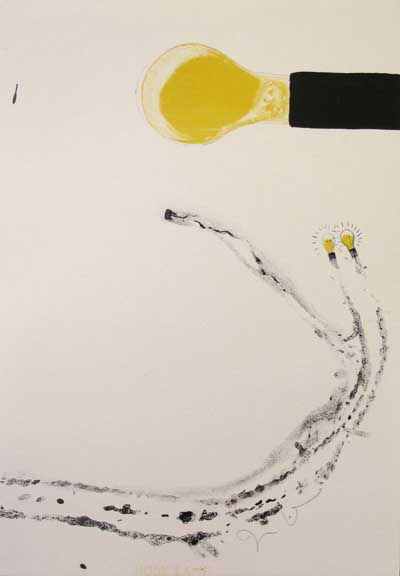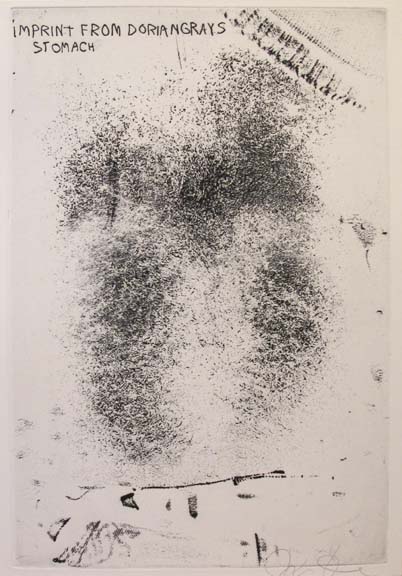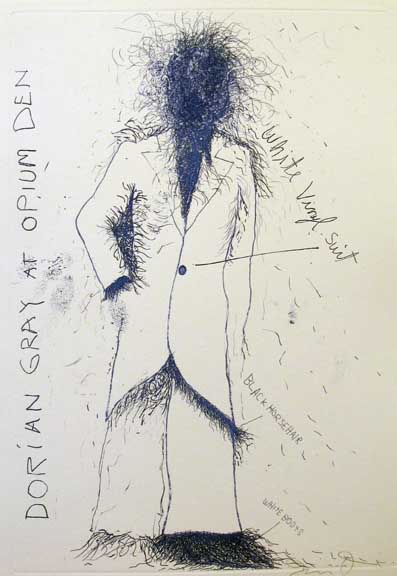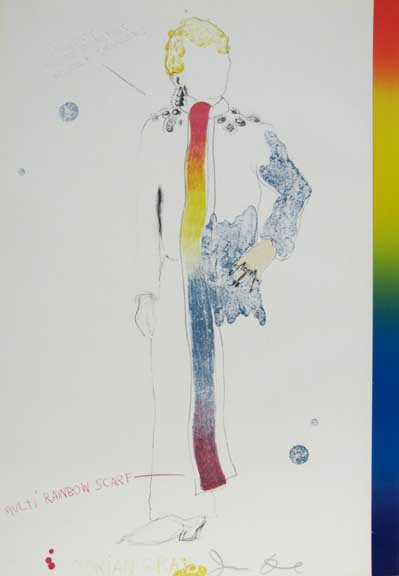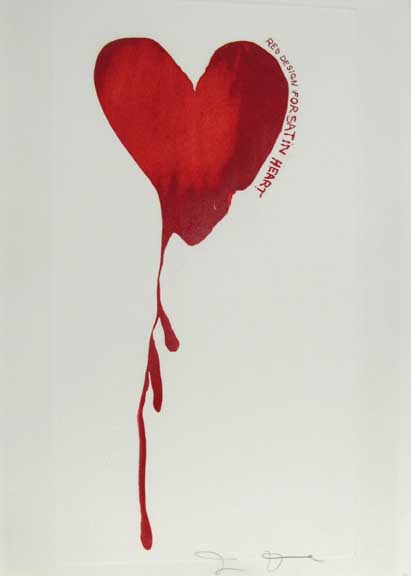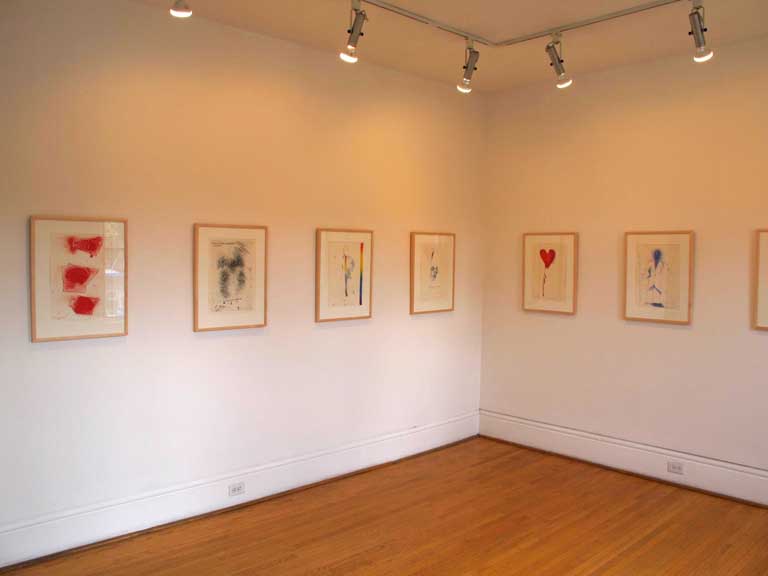The Picture of Dorian Gray
Jim Dine
October 15 - November 13, 2010

We are pleased to present "The Picture of Dorian Gray" lithographs and etchings produced in 1968 by American artist Jim Dine. This body of work functions like a seedbed of ideas that Dine has explored in various printmaking media to this day. Works from this series are in the permanent collection at the Art Gallery of Ontario and were exhibited in 2005 in conjunction with drawings by Ron Giii. Curator Michelle Jacques provided the following text for this exhibition:
"Jim Dine published these lithographs in 1968 as illustrations for a stage script of Oscar Wilde's novel, The Picture of Dorian Gray. The story of a wealthy and beautiful young man who trades his soul for eternal youth, Dorian Gray depicts depravity and vanity in a now classic examination of what happens when one tries to resist inevitable change.
"While most productions of Dorian Gray situate the narrative at the end of the 19th century, when the novel was written and published, Dine’s costumes and props possess an unmistakably sixties feel. Dorian's vinyl cloak, his fiancée Sybil's modern undergarments, and portrait painter Basil's stylish black leather suit all serve to situate Wilde's classic story of vanity and depravity firmly in the artist's own time."
This exhibition is presented in conjunction with "Printopolis", a 4-day symposium with an international focus on contemporary printmaking, October 21-24, 2010. See www.openstudio.ca
JIM DINE: Biography I
Jim Dine was born in Cincinnati, Ohio in 1935. He grew up in what he regards as the beautiful landscape of the Midwest, a tone and time to which he returns constantly. He studied at the University of Cincinnati and the Boston Museum School and received his BFA from Ohio University in 1957.
Dine, renowned for his wit and creativity as a Pop and Happenings artist, has a restless, searching intellect that leads him to challenge himself constantly. Over four decades, Dine has produced more than three thousand paintings, sculptures, drawings, and prints, as well as performance works, stage and book designs, poetry, and even music. His art has been the subject of numerous individual and group shows and is in the permanent collections of museums around the world.
Dine's earliest art - Happenings and an incipient form of pop art - emerged against the backdrop of abstract expressionism and action painting in the late 1950s. Objects, most importantly household tools, began to appear in his work at about the same time; a hands-on quality distinguished these pieces, which combine elements of painting, sculpture, and installation, as well as works in various other media, including etching and lithography. Through a restricted range of obsessive images, which continue to be reinvented in various guises - bathrobe, heart, outstretched hand, wrought-iron gate, and Venus de Milo - Dine presents compelling stand-ins for himself and mysterious metaphors for his art.
The human body conveyed though anatomical fragments and suggested by items of clothing and other objects, emerges as one of Dine's most urgent subjects. Making use of the language of expressionism and applying it to themes concerning the artist as a creative but solitary individual, Dine ultimately asserts himself as a late-twentieth-century heir to the romantic tradition.
JIM DINE: Biography II
Born in 1935 at Cincinnati, Ohio. He studied at the University of Cincinnati and at the Boston School of Fine and Applied Arts in Boston, Massachusetts from 1953 to 1957. In 1957 he received a Bachelor of Fine Arts degree from the Ohio University, Athens. He moved to New York in 1959. He staged his first Happenings with Claes Oldenburg and Allan Kaprow at the Judson Gallery, New York. He had his first one- man exhibition at the Reuben Gallery, New York. Between 1960 and 1965 he had various guest professorships, among others at Yale University, New Haven, and Oberlin College, Ohio. He was represented at the Venice Biennale in 1964, and at Documenta "4" in Kassel in 1968.
From the early 1970s Dine's oil paintings, prints (perhaps his most successful work, usually sensitive and simple depictions of tools, robes, etc.) and drawings became increasingly figurative. In 1957 he received a bachelor of fine arts degree from Ohio University. After graduation, he moved to New York City and became involved with Robert Rauschenberg, Claes Oldenburg, and Roy Lichtenstein whose work moved away from abstract expressionism toward pop art.
Dine incorporated images of everyday objects in his art, but he diverged from the coldness and impersonal nature of pop art by making works that fused personal passions and everyday experiences. His repeated use of familiar and personally significant objects, such as a robe, hands, tools, and hearts, is a signature of his art. In his early work, Dine created mostly assemblages in which he attached actual objects to his painted canvases. From 1959 to 1960, Dine also was a pioneer of happenings, works of art that took the form of theatrical events or demonstrations.
In 1967 Dine and his family moved to London, England, where he devoted his energies to printmaking and drawing. Dine's attention turned to sculptural work in the early 1980s when he created sculptures based on the sculpture Venus de Milo.
His recent art uses imagery borrowed from ancient Greek, Egyptian, and African objects. In his paintings, drawings, sculptures, graphics, collages and assemblages he combined different techniques with handwritten texts and words and set real everyday objects against undefined backgrounds. The objects were both commonplace and personal, both poetic and ironic, reflecting his feelings about life. His constantly varied bathrobe, transparent to the gaze of the world, was a kind of metaphor for a self-portrait.
JIM DINE: Selected Public Collections
Metropolitan Museum of Modern Art, the Solomon R. Guggenheim Museum, the Whitney Museum of American Art, the Jewish Museum, NY; National Gallery, Washington DC; Boston Museum of Fine Art; Art Institute of Chicago; Los Angles County Museum; Art Museum, Princeton University; Fogg Art Museum, Harvard University; High Museum of Art, Atlanta; Cincinnati Art Museum, Akron Art Institute, Ohio; Dallas Museum of Art; New Orleans Museum of Art; Stedelijk Museum, Amsterdam, Netherlands; Tate Gallery, London, Tokyo Metropolitan Art Museum; Western Australian Museum, Perth; Israel Museum, Jerusalem; Art Gallery of Ontario, Toronto, Canada.
(this biography was found at http://www.leninimports.com/jim_dine.html)













